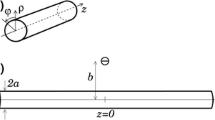Abstract
This paper describes a model of the frog skeletal muscle fiber that includes the effects of the transverse tubular system (T system) on propagation. Uniform propagation on an isolated fiber suspended in Ringer’s solution or in air is simulated by placing the cylindrical fiber model in a concentric three-dimensional isotropic volume conductor. The current through the T system outlets at the sarcolemmal surface is comparable in magnitude to the sarcolemmal current density, but is of opposite polarity. When it is added to the sarcolemmal current, the resulting triphasic waveform has a 100% increase in the leading positive peak, a 50% reduction in the negative peak, and more than 60% reduction in the trailing positive peak. As a result the tubular output current causes a reduction in the conduction, velocity, a decrease in the maximum rate of rise of the action potential, and an important modification of the extracellular potential. Compared to an isolated fiber in a large volume of Ringer’s solution, uniform propagation within a 2-μm-thick volume conductor annulus is slowed down from 1.92 to 0.72 m/s, and the extracellular potential is increased from 1 to 108 mV peak to peak, in agreement with published experimental measurements.
Similar content being viewed by others
References
Abramowitz, M. and I. A. Stegun.Handbook of Mathematical Functions. New York: Dover, 1970, 1046 pp.
Adrian, R. H., W. K. Chandler, and A. L. Hodgkin. Voltage clamp experiments in striated muscle fibers.J. Physiol. (Lond.) 208:607–644, 1970.
Adrian, R. H., W. K. Chandler, and A. L. Hodgkin. The kinetics of mechanical activation in frog muscle.J. Physiol. (Lond.) 204:207–230, 1969.
Adrian, R. H. and L. D. Peachey. Reconstruction of the action potential of frog Sartorius muscle.J. Physiol. (Lond.) 235:103–131, 1973.
Andreassen, S. and A. Rosenfalck. Relationship between intracellular and extracellular action potentials of skeletal muscle fiber.CRC Crit. Rev. Bioeng. 6:267–306, 1981.
Buchthal, F., C. Guld, and P. Rosenfalck. Volume conduction of the spike of the motor unit potential investigated with a new type of multielectrode.Acta Physiol. Scand. 38:331–354, 1957.
Buchthal, F. and O. Steen-Knudsen. Impulse propagation in striated muscle fibers and the role of the internal currents in activation.Ann. N.Y. Acad. Sci. 81:422–445, 1959.
Campbell, D. T. and B. Hille. Kinetic and pharmacological properties of the sodium channel of the frog skeletal muscle.J. Gen. Physiol. 67:309–323, 1976.
Fatt, P. An analysis of the transverse electrical, impedance of striated muscle.Proc. R. Soc. Lond. B. 159:606–651, 1964.
Fletcher, C. A. J.Computational Techniques for Fluid Dynamics (second edition), Vol. 1. Berlin: Springer Verlag, 1991, 401 pp.
Gage, P. W. and R. S. Eisenberg. Action potentials, after potentials, and excitation-contraction coupling in frog Sartorius fibers without transverse tubules.J. Gen. Physiol. 53: 298–310, 1969.
Ganapathy, N. and J. W. Clark. Extracellular potentials from skeletal muscle.Math. Biosc. 83:61–96, 1987.
Henneberg, K. and F. A. Roberge. Simulation of propagation in a bundle of skeletal muscle: modulation effects of passive fibers.Ann. Biomed. Eng. 1997.
Hille, B.Ionic Channels of Excitable Membranes. Sunderland, MA: Sinauer Associates, 1992, 607 pp.
Hodgkin, A. L. and S. Nakajima. The effect of diameter on the electrical constants of frog skeletal muscle fibers.J. Physiol. (Lond.) 221:105–120, 1972.
Hodgkin, A. L. and S. Nakajima. Analysis of the membrane capacity in frog muscle.J. Physiol. (Lond.) 221:121–136, 1972.
Huang, C. L.-H. and L. D. Peachey. A reconstruction of charge movement during the action potential in frog skeletal muscle.Biophys. J. 61:1133–1146, 1992.
Håkansson, C. H. Conduction velocity and amplitude of the action potential as related to circumference in the isolated fibre of frog muscle.Acta Physiol. Scand. 37:14–34, 1956.
Håkansson, C. H. Action potentials recorded intra- and extracellularly from the isolated frog muscle fibre in Ringer’s solution and in air.Acta Physiol. Scand. 41:190–216, 1957.
Ildefonse, M. and G. Roy. Kinetic properties of the sodium current in striated muscle fibres on the basis of the Hodgkin-Huxley theory.J. Physiol. (Lond.) 227:419–431, 1972.
Lathi, B.Signals, Systems, and Controls. New York: Harper and Row, 1974, 524 pp.
Mathias, R. T., R. S. Eisenberg, and R. Valdiosera. Electrical properties of frog skeletal muscle fibers interpreted with a mesh model of the tubular system.Biophys. J. 17:57–93, 1977.
Mobley, B. A. and B. Eisenberg. Sizes of components in frog skeletal muscle measured by methods of stereology.J. Gen. Physiol. 66:31–45, 1975.
Nakajima, S. and A. Gilai. Radial propagation of muscle action potential along the tubular system examined by potential-sensitive dyes.J. Gen. Physiol. 76:751–762, 1980.
Peachey, L. D. and R. H. Adrian. Electrical properties of the transverse tubular system. In:Structure and Function of Muscle, Vol. 3, edited by G. Bourne. New York: Academic Press, 1973, pp. 1–29.
Peachey, L. D. and C. Franzini-Armstrong. Structure and function of membrane systems of skeletal muscle cells. In:Handbook of Physiology, Vol. 10:Skeletal Muscle, edited by L. D. Peachey. Bethesda, MD: American Physiol Society, 1983, pp. 23–71.
Plonsey, R. Effect of intracellular anisotropy on the electrical source determination in a muscle fibre.Med. Biol. Eng. Comput. 28:312–316, 1990.
Press, W. H., B. P. Flannery, S. A. Teukolsky, and W. T. Vetterling.Numerical Recipes: The Art of Scientific Computing. Cambridge: Cambridge University Press, 1987, 818 pp.
Rosenfalck, P. Intra- and extracellular potential fields of active nerve and muscle fibres.Acta Physiol. Scand. Suppl. 321:1–168, 1969.
Schneider, M. F. Linear electrical properties of the transverse tubules and surface membrane of skeletal muscle fibers.J. Gen. Physiol. 56:640–671, 1970.
Stockbridge, N. Solution of the Hodgkin-Huxley and cable equations on an array processor.Ann. Biomed. Eng. 17:253–268, 1989.
Valdiosera, R., C. Clausen, and R. S. Eisenberg. Impedance of frog skeletal muscle fibers in various solutions.J. Gen. Physiol. 63:460–491, 1974.
van Veen, B. K., H. Wolters, W. Wallinga, W. L. C. Rutten, and H. B. K. Boom. The bioelectric source in computing single muscle fiber action potentials.Biophys. J. 64:1492–1498, 1993.
Author information
Authors and Affiliations
Rights and permissions
About this article
Cite this article
Henneberg, KÅ., Roberge, F.A. Simulation of propagation along an isolated skeletal muscle fiber in an isotropic volume conductor. Ann Biomed Eng 25, 15–28 (1997). https://doi.org/10.1007/BF02738535
Received:
Accepted:
Issue Date:
DOI: https://doi.org/10.1007/BF02738535




